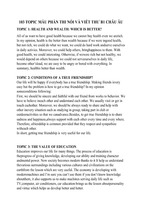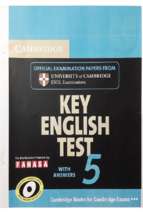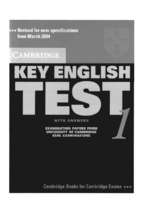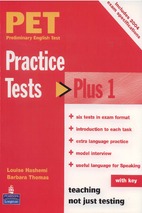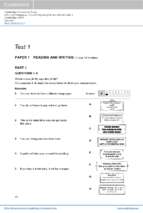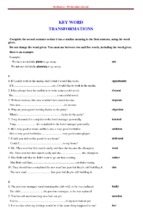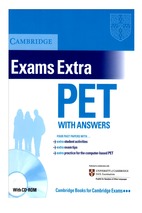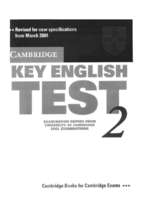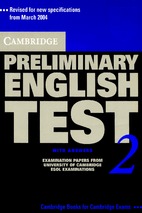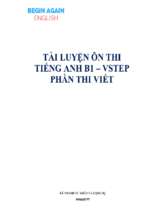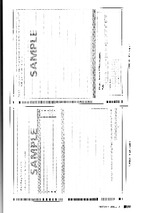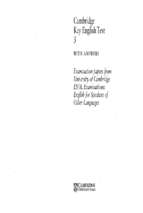VIETNAM NATIONAL UNIVERSITY, HANOI
VIETNAM JAPAN UNIVERSITY
LE THI VAN
INTENSIFIED PHOSPHORUS REMOVAL
FROM SYNTHETIC WASTEWATER BY
LAB-SCALE HORIZONTAL SUB-SURFACE
FLOW CONSTRUCTED WETLANDS USING
A MIXTURE OF COAL SLAG AND
CALCINED FERRALSOLS AS SUBSTRATE
MASTER'S THESIS
VIETNAM NATIONAL UNIVERSITY, HANOI
VIETNAM JAPAN UNIVERSITY
LE THI VAN
INTENSIFIED PHOSPHORUS REMOVAL
FROM SYNTHETIC WASTEWATER BY
LAB-SCALE HORIZONTAL SUB-SURFACE
FLOW CONSTRUCTED WETLANDS USING
A MIXTURE OF COAL SLAG AND
CALCINED FERRALSOLS AS SUBSTRATE
MAJOR: ENVIRONMENTAL ENGINEERING
CODE: 8520320.01
SUPERVISORS:
Principal Supervisor: Dr. NGUYEN THI AN HANG
Co-Supervisor: Assoc. Prof. Dr. SATO KEISUKE
Hanoi, 2020
ACKNOWLEDGEMENTS
First and foremost, I would like to express my deep gratitudes to Dr. Nguyen Thi An
Hang, my Principal Supervisor, who gave me the opportunity to get involved in this
interesting research. She not only provided me valuable advices on this research but also
strengthened my research skills, built up my confidence, and encouraged me to overcome
all difficulties. It would have been impossible to fulfill this work without her enthusiastic
supports.
I extend my sincere thanks to Assoc. Prof. Dr. Sato Keisuke, my Co-supervisor, who gave
me practical advices on the feasibility and applicability of my research. It was very kind of
him to give me opportunities to learn about Japanese culture and people, which will
definitely be useful for my future.
My gratitude is also gone to Dr. Vu Ngoc Duy for his extraordinary supports. I was
immensely benefited from his continuous assistance in constructed wetlands setting up and
experimental data processing.
My special thanks go to B.Sc. Nguyen Thi Xuyen, the project assistant, for her helps with
taking care of CWs system during the global COVID-19 pandemic period. For me, she is a
sincere friend and I have learnt a lot from her.
I would like to acknowledge VNU Vietnam Japan University (VJU), Ritsumeikan
University (RITs), and Hiyoshi Corporation for providing me the best conditions to study
and have internship in Vietnam and Japan. Especially, I am so grateful to Prof. Jun
Nakajima and Prof. Soda Satoshi for teaching me at VJU and supporting me during my
internship in Japan.
This research was completed in the laboratory of the Master’s Program in Environmental
Engineering (MEE), VNU Vietnam Japan University (VNU-VJU). I would like to
acknowledge Vietnam National Foundation for Science and Technology Development
(NAFOSTED) [grant number 105.99-2018.13, 2018], and Asia Research Center, Vietnam
National University, Hanoi (ARC-VNU) and Korea Foundation for Advanced Studies
(KFAS) [grant number CA.18.11A, 2018] for financial supports.
i
Lastly, I would like to express my deep gratitudes to my parents for raising me with a love
of science and supporting me in all my pursuits. My heartfelt thanks go to Son-san for his
love, accompanying, and comments on my thesis research. Thank you all my friends, who
were MEE Batch 3 students, for unforgettable memories.
Hanoi, June 14th 2020
Le Thi Van
ii
TABLE OF CONTENTS
ACKNOWLEDGEMENTS...............................................................................................i
TABLE OF CONTENTS................................................................................................ iii
LIST OF TABLES...........................................................................................................vi
LIST OF FIGURES........................................................................................................ vii
LIST OF ABBREVIATIONS...........................................................................................x
INTRODUCTION............................................................................................................ 1
CHAPTER 1: LITERATURE REVIEW..................................................................... 4
1.1. Pig farming in Vietnam..................................................................................... 4
1.1.1. Pig farming development in Vietnam..................................................... 4
1.1.2. Environmental concerns of anaerobically treated swine wastewater...5
1.2. Phosphorus pollution and remedy technologies................................................8
1.2.1. Phosphorus significance and environmental concern........................... 8
1.2.2. Technologies for phosphorus decontamination of anaerobically
treated swine wastewater (ATSWW).............................................................. 10
1.3. Constructed wetlands.......................................................................................11
1.3.1. Definition.............................................................................................. 11
1.3.2. Classification of constructed wetlands (CWs)..................................... 12
1.3.3. Phosphorus removal by different components in CWs........................ 14
1.3.4. Advantages and disadvantages of CWs in P removal from
wastewater...................................................................................................... 21
1.4. Study subjects.................................................................................................. 22
1.4.1. Filter materials..................................................................................... 22
1.4.2. Plants.................................................................................................... 26
CHAPTER 2: MATERIALS AND METHODS........................................................28
2.1. Materials...........................................................................................................28
2.1.1. Substrates..............................................................................................28
iii
2.1.2. Wetland plants...................................................................................... 31
2.2. Experimental set-up......................................................................................... 33
2.2.1. Ferralsols calcination.......................................................................... 33
2.2.2. Adsorption tests.................................................................................... 34
2.2.3. Constructed wetlands design and operation........................................36
2.3. Analytical methods and equipment................................................................. 38
2.3.1. Substrate characterization....................................................................38
2.3.2. Environmental parameters analysis.....................................................41
2.4. Calculation and statistical analysis..................................................................44
2.4.1. Calculation............................................................................................44
2.4.2. Statistical analysis................................................................................ 44
CHAPTER 3: RESULTS AND DISCUSSION..........................................................45
3.1. Ferrasols calcination for P removal enhancement.......................................... 45
3.1.1. Lab-scale Ferralsols calcination......................................................... 45
3.1.2. Large-scale Ferralsols calcination...................................................... 46
3.2. Adsorptive behaviours of calcined Ferrasols.................................................. 46
3.2.1. Factors influencing P adsorption.........................................................46
3.2.2. Adsorption isotherms............................................................................50
3.2.3. Adsorption kinetics............................................................................... 55
3.3. Characterization of the filter materials............................................................57
3.3.1. Characterization of natural and calcined Ferralsols.......................... 57
3.3.2. Characterization of coal slag............................................................... 64
3.4. Applicability of the investigated filter materials.............................................66
3.5. Treatment performance of sub-surface horizontal flow constructed
wetlands...................................................................................................................67
3.5.1. P treatment performance......................................................................67
3.5.2. Side-effects of filter materials on HSSF-CWs effluents....................... 69
CHAPTER 4: CONCLUSIONS AND RECOMMENDATIONS............................73
iv
4.1. Conclusions......................................................................................................73
4.2. Recommendations............................................................................................73
REFERENCES................................................................................................................75
APPENDICES.................................................................................................................89
v
LIST OF TABLES
Table 1.1. Treatment efficiency of piggery wastewater by anaerobically treatment in
Thua Thien Hue .............................................................................................. 7
Table 1.2. P removal mechanisms of CWs components ..............................................14
Table 1.3. Effect of nutrient uptake by plants on removal of nitrogen and
phosphorus (%) in different CWs simulated scenarios ................................19
Table 2.1. Parameters of real post-anarobically swine wastewater in Hanoi................ 33
Table 3.1. Comparison of P adsorption capacity of investigated filter materials..........45
Table 3.2. Coparing CF500 produced in lab-scale and large-scale............................... 46
Table 3.3. Langmuir and Freundlich adsorption isotherm constants.............................53
Table 3.4. P adsortion capacity of different materials....................................................54
Table 3.5. Kinetic constants............................................................................................57
Table 3.6. Mineral composition of NF and CF500 samples.......................................... 60
Table 3.7. Main chemical compositions of NF, CF500 and CS.................................... 60
Table 3.8. Types of vibration peak in NF and CF500....................................................62
Table 3.9. The chemical compositions in CF500 and NF..............................................62
Table 3.10. Hydraulic properties of CF500 compared with other materials................. 64
Table 3.11. The chemical compositions in CS...............................................................65
Table 3.12. Physical properties of CS compared with other materials..........................65
Table 3.13. Selection the mixing ratio of CF500 and CS.............................................. 66
Table 3.14. The concentration of 6 heavy metals in post-adsorption solutions............ 71
vi
LIST OF FIGURES
Figure 1.1. Distribution of pig production in Vietnam by ecological regions .......... 5
Figure 1.2. Swine wastewater .....................................................................................6
Figure 1.3. P is an important and essential nutrient for plants .................................. 8
Figure 1.4. HABs are triggered by nutrient enrichment ............................................ 9
Figure 1.5. Stabilization lagoon................................................................................. 11
Figure 1.6. Classification of CWs ............................................................................ 12
Figure 1.7. The diagram of VSSF-CWs ...................................................................13
Figure 1.8. HSSF-CWs .............................................................................................14
Figure 1.9. P adsorption mechanism on material surface ........................................ 16
Figure 1.10. Phytoremediation Using Aquatic Plants ..............................................17
Figure 1.11. Rhizosphere in CWs plants ..................................................................18
Figure 1.12. Phosphorus cycle in constructed wetland ............................................18
Figure 1.13. Source structure of the national electricity system by primary energy 22
Figure 2.1. Pha Lai Thermal Power Joint Stock Company....................................... 28
Figure 2.2. Principle diagram of electricity production technology..........................29
Figure 2.3. Sampling location of Ferralsols in Dak Nong Province......................... 30
Figure 2.4. Stone placed at the bottom of CW units..................................................31
Figure 2.5. Sand added on the top of CWs units....................................................... 31
Figure 2.6. Aquatica ipomoea planted from seeds on the soil before being
transferred into CW units....................................................................................32
Figure 2.7. Cymbopogon citratus kept alive in the tap water before being transferred
into CW units...................................................................................................... 32
Figure 2.8. Aquatica ipomoea at the time being tranferred into CWs.......................32
Figure 2.9. Carbolite furnace ....................................................................................33
Figure 2.10. Preparing NF for calcination with the commcerical furnace................ 34
Figure 2.11. Layers structure of tanks in CWs.......................................................... 37
Figure 2.12. Nutrient solution storage tank................................................................38
vii
Figure 2.13. The HSSF-CWs system planted with water spinach and lemongrass.. 38
Figure 2.14. AMRAY Model 1830 Scanning Electron Microscope......................... 40
Figure 2.15. Empyrean equipment ........................................................................... 40
Figure 2.16. X-ray fluorescence spectrometer .......................................................... 41
Figure 2.17. FTIR Spectrometer .............................................................................. 41
Figure 2.18. Shaker ...................................................................................................42
Figure 2.19. UV/Vis Diode Array Spectrophotometer ............................................ 42
Figure 2.20. The pH meter ....................................................................................... 42
Figure 2.21. The SensION + EC5, Hach, China........................................................43
Figure 2.22. Atomic absorption spectrophotometer ................................................ 43
Figure 3.1. Effect of pH of NF and CF500 on P removal......................................... 47
Figure 3.2. Effect of dosage of NF and CF500 on P removal................................... 49
Figure 3.3. Effect of temperature of CF500 on P removal........................................ 50
Figure 3.4. The fitting Langmuir and Freundlich isotherm models.......................... 51
for P adsorption by CF500......................................................................................... 51
Figure 3.5. The fitting Langmuir and Freundlich isotherm models for P adsorption
by NF...................................................................................................................51
Figure 3.6. The fitting Langmuir and Freundlich isotherm modelts for P adsorption
by CS................................................................................................................... 52
Figure 3.7. Linear form of adsorption isortherms: a) Langmuir model and b)
Freundlich model of CF500................................................................................52
Figure 3.8. Linear form of adsorption isortherm following a) Langmuir model and b)
Freundlich model of NF......................................................................................53
Figure 3.9. Linear forms of adsorption isortherms: a) Langmuir model and b)
Freundlich model of CS......................................................................................53
Figure 3.10. Kinetic curve of CF500..........................................................................55
Figure 3.11. Kinetic curve of NF............................................................................... 56
Figure 3.12. Kinetic curve of of CS........................................................................... 56
Figure 3.13. SEM observation for a) NF and b) CF500............................................ 58
Figure 3.14. XRD spectrum of NF.............................................................................59
Figure 3.15. XRD spectrum of CF500....................................................................... 59
viii
Figure 3.16. FTIR analysis for NF and CF500.......................................................... 61
Figure 3.17. The P removal efficiency of 4 units of CWs......................................... 67
Figure 3.18. The change of P concentration in the effluent over the time................ 68
Figure 3.19. pH of post-adsorption solutions.............................................................70
Figure 3.20. EC of post-adsorption solutions............................................................ 71
ix
LIST OF ABBREVIATIONS
ATP
Adenosine triphosphate
BOD
Biochemical oxygen demand
COD
Chemical oxygen demand
CWs
Constructed wetlands
DNA
Deoxyribonucleic acid
DO
Oxygen demand
FAO
Food and agriculture organization
FWS-CWs
Free water surface constructed wetlands
HSSF-CWs
Horizontal sub-surface flow constructed wetlands
N
Nitrogen
P
Phosphorus
RNA
Ribonucleic acid
SSF-CWs
Sub-surface flow constructed wetlands
SS
Suspended solid
TKN
Total Kjeldahl nitrogen
TP
Total phosphate
VSSF-CWs
Vertical sub-surface flow constructed wetlands
x
INTRODUCTION
According to the Food and Agriculture Organization (FAO), Asia is one of the
largest producers and consumers of livestock products (Vu, 2019). The pig breeding
industry in Asia develops at a very fast pace but it is mainly spontaneous and has
not yet met the technical standards of breeding facilities and breeding techniques
(Le, 2014). Therefore, the swine wasteawter normally contains high levels of
pathogens, nirogen (N), and phosphorus (P) (Vietnam National Environment Report,
2014). Nowadays, there are variable technologies for treating livestock wastewater
such as: The upflow sludge blanket filteration, USBF (Truong, 2010); stabilization
lakes (Nguyen, 2011); upflow anaerobic sludge blanket, UASB (Rodrigues, 2010),
anaerobic reactor of expanded granular sludge bed - EGSB (Lee, 2012). In Vietnam,
anaerobic treatment is considered an appropriate solution to treat wastewaters
containing high contents of organic matter and suspended solids such as swine
wastewater. However, this technology is not the final stage in the treatement system
to ensure the criteria for safe discharge into the environment (Nguyen, 2012).
Therefore, it is necessary to implement additional treatment to swine wastwater
after anaerobic treatment before discharging it into the environment.
Phosphorus is an important element in all known life forms. Inorganic P in the form
PO43- plays an important role in biological molecules such as Deoxyribonucleic acid
(DNA) and Acid ribonucleic (RNA). On the other side, P at high concentration is
one of the causes of water pollution with phenomena known as eutrophication and
toxic algae. According to QCVN 40: 2011/BTNMT (column B), the discharge limit
for P in the industrial wastewater is 6 mg/L.
Constructed wetland (CW) is one of technologies for wasteawter treatment, which
is based on the natural functions of filter materials, platns and microorganisms
(Vymazal, 2007). CWs have many advantages, namely simple operation, less
maintaining demand, low energy requirement, green teachnology, and especially are
suitable for small communities as a decentralized technology (Wu, 2015).
1
In the CWs, P can be removed from wastewater via several pathways, such as
sorption onto filter materials, plant uptake and microbial assimilation (Vymazal,
2008). Of which, the role of filter materials is domninant, with the removal
mechanisms as follows: adsorption, precipitation, settling, etc. (Wu et al., 2015).
Regarding the P treatment performance, the horizontal subsurface flow CWs
(HSSF-CWs) were found to be more efficient than other types of CWs, such as
vertical subsurface flow CWs (VSSF-CWs), free water surface CWs (FWS-CWs)
(Arun,2019). Even in the HSSF-CWs, their P removal ability is usually low and
unstable. To overcome this challenge, this study aims at enhancing the P removal
efficiency of HSSF-CWs by utilizing a mixture of an industrial by-product (coal
slag) and a natural material (Ferralsols) as the filter materials and accumulating
plants, namely water spinach (Aquatica ipomoea) and lemongrass (Cymbopogon
citratus). To achieve this ultimate goal, a research titled “Intensified phosphorus
removal from synthetic wastewater by lab-scale horizontal sub-surface flow
constructed wetlands using a mixture of coal slag and calcined ferralsols as
substrate” was carried out with the specific objectives as follows: (i) Improve P
sorption capacity of raw ferralsols (NF) by calcination, (ii) Investigate the
adsorption behaviors, (iii) Evaluate the P treatment performance of the HSSF-CWs
using mixture of filter materials and acumulating plants, and (iv) Elucidate possible
side-effects of using the selected media in HSSF-CWs.
This thesis comprises of 4 main Chapters with the following major contents:
Introduction: This part gave the research background, objectives, scope and scale,
and research significance.
Chapter 1. Literature review: This Chapter provided overall information about
environmental problems related to P pollution, the discharge standsards for P
containing wastwater, numerous technologies for P decontamination from
wastewater. In addition, the composition of swine wastwater after anaerobic
treatment was investigated. Especially, this chapter focuses on the CWs,
highlighting the roles of filter media and wetland plants.
2
Chapter 2. Materials and methods: This Chapter introduced materials, methods
and equipments used for this research. Also, the experimental set-up was described
in details.
Chapter 3. Result and discussion: This Chapter referred the results on calcination
of Ferralsols for strengthenning its P removal ability, characterization of raw and
calcined materials, adsorption behaviors, and treatment perfomance of the
HSSF-CWs using the selected filter materials and plants, and side-effects of using
materials in HSSF-CWs.
Chapter 4. Conclusions and recommendations: This Chapter provided the key
findings obtained from this results as well as suggestions for future research.
Appendices. This part consisted of pictures of research activities of this work.
3
CHAPTER 1: LITERATURE REVIEW
1.1. Pig farming in Vietnam
1.1.1. Pig farming development in Vietnam
According to the Food and Agriculture Organization (FAO), Asia will become the
largest producer and consumer of livestock products (Vu, 2019). Therefore,
Vietnam's livestock needs to maintain a high growth rate to meet the domestic
consumption demand and to serve the export. According to the Ministry of
Agriculture and Rural Development (MARD), the annual growth rate of the
livestock in the period of 2008-2019 was relatively high and stable, representing
5-6%. In the draft Strategy for livestock development (Ministry of Industry and
Trade, 2019) from 2020 to 2030, the average annual growth rate for the periods of
2020-2025 and 2025-2030 were predicted to be 4-5% and 3-4%, respectively.
Livestock in general and pig production contribute significantly to Vietnam's GDP
growth. According to the Global Environmental Strategy Institute, agriculture sector
accounted for 25% of the country's GDP in 2014. In particular, the pig industry
represented 71% of the GDP of the entire agriculture sector (Pham, 2017). The
number of pig farming households with a scale of 100 pig heads or more was
30,926, accounting for 1.04% of the total pig breeding households throughout the
country [1]. However, small-scale animal husbandry still dominates due to the
conditions in Vietnam. Pig production is concentrated mainly in areas Red River
Delta and Northem Uplands according to the result presented in Figure 1.1.
4
Figure 1.1. Distribution of pig production in Vietnam by ecological regions
(Nguyen, 2017a)
1.1.2. Environmental concerns of anaerobically treated swine wastewater
According to the study of Le (2014), the pig breeding industry develops at a very
fast pace but it is mainly spontaneous and has not yet met the technical standards of
breeding facilities and breeding techniques. Pollution caused by pig breeding
includes solid waste, air pollution and water pollution. One pig emits 1.5 kg of
manure daily and gradually increases with body weight. Livestock solid waste
contains large amounts of organic matter from manure, uneaten food, straw, etc. It
contains many pathogenic microorganisms and high nitrogen (N), phosphorus (P)
content (National Environment Report 2014). On the other hand, livestock and
slaughtering contribute up to 26% of greenhouse gas emissions (GHGs) in the total
emissions caused by animals (Tambone, 2015). In addition, odor is also a cause of
air pollution in the livestock sector. However, livestock wastewater is the most
significant source of pollution. This is a type of wastewater generated from
livestock activities including urine, rinse water, and bathing water for cattle and
may contain part or all of animal manure. Wastewater accounts for the majority of
livestock wastes because 1 kg of livestock solid waste can be mixed with 20 to 49
kg of water (Nguyen, 2011b).
5
Figure 1.2. Swine wastewater (Nguyen, 2019a)
Nowadays, there are various technologies for treating livestock wastewater such as
The Upflow Sludge Blanket filtration, USBF (Truong, 2010); Stabilization lakes
(Nguyen, 2011); Upflow anaerobic sludge blanket, UASB (Rodrigues, 2010),
Anaerobic reactor of expanded granular sludge bed - EGSB (Lee, 2012). However,
the most common technology in livestock wastewater treatment is anaerobically
digestion. According to Cu (2012), biogas technology is commonly used to produce
electricity and heat in the developing countries. Anaerobically digestion have ability
to reduce emissions GHGs from manure and generating renewable energy (Møller,
2004; Sommer, 2004). There are millions of biogas tanks overworld, in which,
roughly 3.8 million are located in India, about 60,000 tanks in Bangladesh and
about 30 million tanks were built in China (Cu, 2012). In Vietnam, Biogas is
considered an appropriate solution to treat wastes contain high concentrations of
organic matter and solids such as pig wastewater. However, the biogas systems are
not the final treatment system to ensure the criteria for safe discharge into the
environment (Nguyen, 2012).
According to previous studies, the parameters of wastewater after the anaerobically
digestion exceeded the permitted standard many times.
6
Table 1.1. Treatment efficiency of piggery wastewater by anaerobically treatment
in Thua Thien Hue (Nguyen, 2012)
Inffluent
TT
Parameter
Unit
1
BOD5
2
Effluent
concentration concentration
Efficiency
(%)
QCVN 40:2011/
BTNMT
( TB±s )
( TB±s )
mg/L
1297±201
307±90
76,3±7,1
50
COD
mg/L
3022±597
463±127
84,7±5,1
150
3
SS
mg/L
2674±712
373±123
86,1±5,4
100
4
VSS
mg/L
1674±485
244±96
85,4±6,1
-
5
TKN
mg/L
608±87
536±89
11,81±6,0
40
6
T-P
mg/L
342±92
318±84
7,0±0,03
6
Fecal
MPN
coliform
/100
21,7×106
10,6×106
51,2
(F.coli)
mL
7
(column B)
-
Accordingly, despite the high treatment efficiency of over 70% for many
parameters, the quality of water after the anaerobically treatment is still not reached
the standard to be discharged into the environment. In detail, BOD5 is 6 times
higher, COD is 3 times, TKN is 13 times, and TP is 57 times higher than the
standard. This result has also been supported by other studies (Ho, 2016; Le, 2017).
In addition, the low treatment efficiency of nutrients (N, P) will create a burden on
the receiving source. Therefore, it is necessary to take additional steps to treat
wastewater after anaerobically treatment before discharging into the environment.
Thus, it can be concluded that pigs breeding is an industry that can bring huge
economic benefits but also certain environmental risks. In particular, the negative
effects caused by livestock wastewater are the most significant. Therefore it is
necessary to study and select appropriate and effective technologies to treat in order
to prevent negative impacts from livestock wastewater.
7
1.2. Phosphorus pollution and remedy technologies
1.2.1. Phosphorus significance and environmental concern
On the one side, P is an important element in all known life forms. Inorganic P in
the form PO43- plays an important role in biological molecules such as DNA and
RNA. Living cells also use P to transport cellular energy through ATP. Almost
process in the cell that uses energy has P in its ATP form. Despite being the 11th
most abundant element on earth, P in nature exists only in the form of P ore and this
is an almost unrecoverable resource (when it takes 10-15 million years to recover)
(Do, 2008). In agriculture, P is an important and essential nutrient for plants, P
deficiency is one of the causes of crop productivity decline (Ryan, 2012).
Figure 1.3. P is an important and essential nutrient for plants (Pennsylvania's
Nutrient Management Act Program, 2005)
On the other side, P is one of the causes of water pollution in the presence
exceeding concentrations. The recognizable manifestation of P pollution are
eutrophication leading to algal blooms. An excessive increase in nutrients,
especially P in surface water, leads to low DO levels, killing fish and aquatic
organisms (Iodache, 2014). Various species of algae (such as microsystis) can
produce dangerous toxins during their life cycle, which are the causes of fishes and
aquatic plants death, destroying ecological balance (Sathasivan, 2009). In addition,
8
- Xem thêm -


